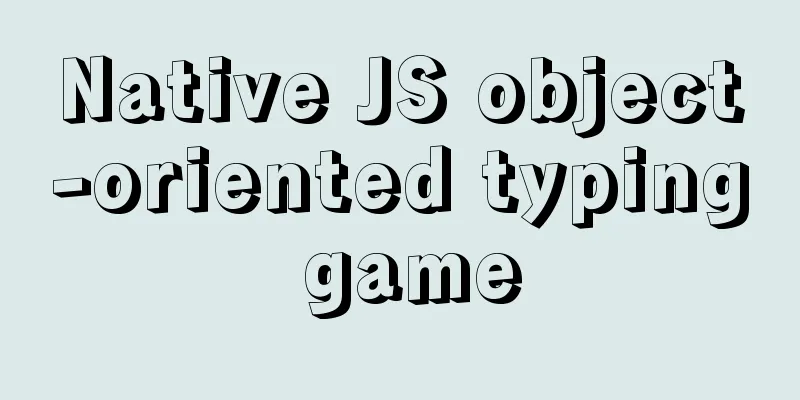Introduction to basic concepts and technologies used in Web development

|
Today, this article introduces some basic concepts and technologies used in Web development to beginners. There are 26 items in total from A to Z, each corresponding to a concept or technology.
AJAX stands for “Asynchronous JavaScript and XML”, which is a web development technology for creating interactive web applications. According to Ajax's creator Jesse James Garrett, AJAX: Use XHTML + CSS to present information; B — Browser A web browser is a piece of software that displays files on a web server or file system and allows users to interact with these files. It is used to display text, images and other information on the World Wide Web or local area network. These texts or images can be hyperlinks to other websites, allowing users to browse various information quickly and easily. Most web pages are in HTML format, and some require specific browsers to display correctly. The common web browsers on personal computers are Microsoft's Internet Explorer, Mozilla's Firefox, Google's Google Chrome, Apple's Safari and Opera from Opera Software, in order of market share in January 2010. The browser is the most commonly used client program. Web developers should ensure that their applications work properly in all major browsers. C — CSS Cascading Style Sheets, also known as: String Style List, English: Cascading Style Sheets, abbreviated as CSS, is a standard defined and maintained by W3C. It is a computer language used to add styles (fonts, spacing, colors, etc.) to structured documents (such as HTML documents or XML applications). The latest version is CSS 2.1, which is a candidate recommended standard of W3C. The next version, CSS 3, is still under development. D — DOM Document Object Model (DOM) is a standard programming interface for processing extensible markup language recommended by the W3C organization. The history of Document Object Model can be traced back to the "browser wars" between Microsoft and Netscape in the late 1990s. In order to fight to the death in JavaScript and JScript, both sides gave browsers powerful functions on a large scale. Microsoft has added many proprietary things to web page technology, including VBScript, ActiveX, and Microsoft's own DHTML format, which makes many web pages unable to display properly using non-Microsoft platforms and browsers. DOM was the masterpiece that was conceived at that time. E — Events An event is an action that can be recognized by a control, such as pressing an OK button or selecting a radio button or check box. Each control has its own identifiable events, such as form loading, click, double-click events, edit box (text box) text change events, etc. Modern Web applications rely heavily on event-driven. Events include system events and user events. System events are triggered by the system, such as a bank depositor's deposit date increases by one day every 24 hours. User events are triggered by the user, such as when the user clicks a button to display specific text in a text box. Event-driven controls perform a certain function. The object that triggers an event is called the event sender; the object that receives the event is called the event receiver. The event mechanism can be used to achieve the following: when a state of a class object changes, the system will call the method in the class that handles this event through some means, or the object that triggers the control event will call all registered event handlers of the control, etc. F — Firebug Firebug is an extension for the web browser Mozilla Firefox and is a debugging tool. Users can use it to debug, edit, and even delete the CSS, HTML, DOM, and JavaScript code of any website. Firebug also provides other web development tools, such as Yahoo!'s web speed optimization suggestion tool YSlow. Firebug was written by Joe Hewitt. He is one of the original creators of Firefox. G — Grid A grid is also called a raster, but by definition, a raster is more accurate. I found a more appropriate definition of the web page grid system on the Internet: using a regular grid array to guide and regulate the layout and information distribution of a web page. The web page grid system is developed from the flat grid system. For web design, the use of grid system can not only make the information presentation on the web page more beautiful and easy to read, but also more usable. Moreover, for front-end development, web pages will be more flexible and standardized. If there are many CSS frameworks that support grid functions, you can refer to the article "Introducing 27 classic CSS frameworks". H — HTML HyperText Markup Language (HTML) is a markup language designed for "creating web pages and other information that can be viewed in a web browser." HTML is used to structure information - such as headings, paragraphs, lists, etc., and can also be used to describe the appearance and semantics of a document to a certain extent. HTML, originally defined by Tim Berners-Lee and further developed by the IETF using a simplified SGML (Standard Generalized Markup Language) syntax, later became an international standard maintained by the World Wide Web Consortium (W3C). The latest version is HTML5 which is the next major revision of HTML and is still under development. The goal is to replace the HTML 4.01 and XHTML 1.0 standards established in 1999, in order to make network standards meet contemporary network needs as Internet applications develop rapidly. When we talk about HTML5 in a broad sense, we actually refer to a set of technologies including HTML, CSS and JavaScript. I — IE Windows Internet Explorer (formerly known as Microsoft Internet Explorer, Internet Explorer for short, abbreviated as IE) is a web browser launched by Microsoft. As of September 2010, statistics show that Internet Explorer's market share is as high as 59.65%. Although it is still the most widely used web browser, its market share is more than 30% lower than its peak in 2003. Internet Explorer has some degree of support for some standardized technologies, but there are also many operational gaps and compatibility failures, which has led to increasing criticism from technology developers. The increase in criticism is largely due to the fact that Internet Explorer's competitors have relatively complete technical support and standards-compliant applications are becoming more and more widespread. Because Internet Explorer is widely used around the world, web developers seeking cross-platform code often find Internet Explorer's vulnerabilities, proprietary feature sets, and incomplete support for standards. Internet Explorer 9, released on March 14, 2011, significantly improved its support for W3C specifications such as CSS3 and HTML5. This version is also the first version of Internet Explorer to use GPU acceleration. The official version scored 95/100 in the Acid3 test, which is a great improvement over previous versions. It can be assumed that starting from Internet Explorer 9, Internet Explorer browser's support for W3C specifications will no longer be a problem. J — JavaScript JavaScript is a scripting language widely used in client-side web development. It is often used to add dynamic functions to HTML web pages, such as responding to various user operations. It was originally designed by Brendan Eich at Netscape and is a dynamic, weakly typed, prototype-based language with built-in support for classes. JavaScript is a registered trademark of Sun Microsystems. Ecma International developed the ECMAScript standard based on JavaScript. JavaScript can also be used in other situations, such as server-side programming. A complete JavaScript implementation consists of three parts: ECMAScript, Document Object Model, and Byte Order Mark. Netscape originally named its scripting language LiveScript, but later changed its name to JavaScript after collaborating with Sun. JavaScript was originally designed with inspiration from Java, one of the goals of which was to "look like Java", so there are similarities in syntax, and some names and naming conventions are also borrowed from Java. But the main design principles of JavaScript are derived from Self and Scheme. The similarity in the names of JavaScript and Java was the result of an agreement reached between Netscape and Sun for marketing considerations at the time. In order to gain a technological advantage, Microsoft launched JScript to compete with JavaScript's scripting language. For interoperability, Ecma International (formerly the European Computer Manufacturers Association) created the ECMA-262 standard (ECMAScript). Both are now ECMAScript implementations. Although JavaScript is promoted and advertised as a scripting language for non-programmers rather than a programming language for programmers, JavaScript has very rich features. K — Keyword Optimization Keyword optimization, also known as Search Engine Optimization (SEO), is a method of using the search engine's search rules to improve the ranking of the target website in the relevant search engine. As many studies have found, search engine users tend to only pay attention to the first few items in the search results, many websites hope to influence the search engine rankings in various ways. This is especially true for websites that rely on advertising for their survival. The so-called "search engine optimization" means making the website more easily accepted by search engines. The search engine will compare the relevance of the content between websites, and then the browser will present the content to the searcher in the fastest and most complete way. Search engine optimization is a crucial task for any website to be successful in website promotion. At the same time, as search engines continue to change their ranking algorithm rules, each change in the algorithm will cause some well-ranked websites to fall out of favor overnight, and the direct consequence of losing ranking is the loss of the website's inherent considerable traffic. Therefore, every change in the search engine algorithm will cause considerable commotion and anxiety among the websites. It can be said that search engine optimization is an increasingly complex task. L — Less Less was originally a Ruby gem that gave CSS the features of a dynamic language, including variables, operators, and nested rules. In fact, the real function of Less is to convert CSS that uses advanced features into standard CSS. These are all done through the Http Handler when the Web client initiates a request. It can also be done during editing. Additionally, Less can be configured to automatically minimize the generated CSS files, saving bandwidth and improving the end-user experience. There is also a .Net version of Less. M — MVC The MVC pattern (Model-View-Controller) is a software architecture pattern in software engineering, which divides the software system into three basic parts: model, view and controller. The MVC pattern was first proposed by Trygve Reenskaug in 1974. It is a software design pattern invented by Xerox PARC for the programming language Smalltalk in the 1980s. The purpose of the MVC pattern is to implement a dynamic program design, simplify subsequent modification and expansion of the program, and make it possible to reuse part of the program. In addition, this mode makes the program structure more intuitive by simplifying the complexity. The software system separates its basic parts and also gives each basic part the corresponding functions. N — Node.JS Node is a Javascript runtime, which is actually a package of the Google V8 engine (used in the Google Chrome browser). The V8 engine executes Javascript very quickly and has very good performance. Node optimizes some special use cases and provides alternative APIs to make V8 run better in non-browser environments. For example, in a server environment, processing binary data is often essential, but Javascript does not support this enough. Therefore, V8.Node adds the Buffer class to process binary data conveniently and efficiently. Therefore, Node not only simply uses V8, but also optimizes it to make it more powerful in various environments. Node.js is a little bit of a cookie cutter, but the main point is that it provides a way to run JavaScript outside of a web browser. Javascript is widely used in front-end development of websites. Node enables this popular programming language to run in more environments, even on the server side of websites. O — Object Object is a term in object-oriented programming. It refers to both a specific thing in the problem space (Namespace) of the objective world and a basic element in the solution space of a software system. In a software system, an object has a unique identifier. An object includes properties and methods. Properties are the information that needs to be remembered, and methods are the services that an object can provide. In object-oriented software, an object is an instance of a class. P — PHP PHP (Hypertext P reprocessor) is a scripting language that runs on computers. Its main purpose is to process dynamic web pages. It also includes a command line interface or generates a graphical user interface (GUI) program. PHP was first invented by Rasmus Lerdorf in 1995, and the PHP standard is now maintained by the PHP Group and the open source community. PHP uses the PHP License as its license agreement, but because this agreement restricts the use of the PHP name, it is incompatible with the open source license agreement GPL. PHP has a wide range of applications, especially in the development of web programs. Generally speaking, PHP mostly runs on web servers, generating web pages that users browse by running PHP codes. PHP can run on most servers and operating systems, and using PHP is completely free. According to statistics from April 2007, PHP has been installed on more than 20 million websites and 1 million servers. Q — Query Query has many meanings. For example, query languages are used to interact with extended systems that store data. A good example is SQL, which is used to operate relational databases. Another meaning is a query string, which is used as part of the URL to pass data in a web application. The format of the query string is generally in the form of key-value pairs. R — Regular Expressions Regular expression (English: Regular Expression, regex or regexp, abbreviated as RE), also translated as formal notation, conventional notation, in computer science, refers to a single string used to describe or match a series of strings that conform to a certain syntactic rule. In many text editors or other tools, regular expressions are often used to retrieve and/or replace text content that matches a certain pattern. Many programming languages support string manipulation using regular expressions. For example, Perl has a powerful regular expression engine built into it. The concept of regular expressions was originally popularized by Unix tools such as sed and grep. S — Source Control Source code management, also known as version control, is a software engineering technique that ensures that the same program files edited by different people are synchronized during the software development process. Software designers often use version control to track and maintain changes to source code, files, and configuration files, and provide procedures for controlling these changes. In the simplest case, a software designer can keep many different versions of a program himself and number them appropriately. This simple approach has been used in many large software projects. This is a method that can achieve the goal, but it is not efficient enough. In addition to maintaining many almost identical code backups at the same time, it is also extremely dependent on the self-cultivation and development discipline of the software designer, which is often the cause of errors. Sometimes, it is necessary to have more than two versions of a program at the same time. For example, in a version for deployment, program errors have been fixed but no new features have been added; in another development version, new features are being developed and new errors are to be resolved, which requires different versions and modifications at the same time. In addition, in order to find a program error that only exists in a specific version, or to find the version in which the program error occurs, software debuggers must also compare different versions of program code to find the location of the problem. T — TDD Test-driven development is a modern computer software development method. Use testing to drive the design and implementation of software programs. Test-driven development became popular in the 1990s. Test-driven development is a program development method advocated in extreme programming. The method mainly involves writing a test program first and then coding it to pass the test. The purpose of test-driven development is to get quick feedback and use an "illustrate the main line" approach to building your program. A metaphor for test driven development. Development can be viewed from two perspectives: the functionality implemented and the quality. Test-driven development is more like a development method of thinking with two hats. First, put on the hat of implementing functions, and with the assistance of testing, quickly implement the correct functions; then put on the hat of refactoring, and under the protection of testing, improve the quality by removing redundant and duplicate codes, improving code reusability. It can be seen that testing is indeed at the core of test-driven development and runs through the entire development process. U — Unit Testing Unit testing (also known as module testing) is a test that verifies the correctness of program modules (the smallest unit of software design). A program unit is the smallest testable part of an application. In procedural programming, a unit is a single program, function, procedure, etc.; for object-oriented programming, the smallest unit is a method, including methods in a base class (superclass), abstract class, or derived class (subclass). Generally speaking, programmers will perform at least one unit test each time they modify a program. It is very likely that multiple unit tests will be performed before and after the program is written to verify that the program meets the work objectives required by the software specification and has no bugs. Although unit testing is not necessary, it is not bad either. This involves policy decisions of project management. V — VIM Vim is a text editor developed from vi. It has a wide variety of functions that facilitate programming, such as code completion, compilation, and error jump, and is widely used among programmers. It is ranked alongside Emacs as the favorite editor for users of Unix-like systems. The first version of Vim was released by Bram Moolenaar in 1991. The original abbreviation was ViI IM itation. As its functions continued to increase, the official name was changed to ViI IM proved. It is now free software released in open source format. W — WordPress WordPress is a blogging platform developed using the PHP language. Users can set up their own blogs on a server that supports PHP and MySQL database. You can also use WordPress as a content management system (CMS). WordPress is a free and open source project licensed under the GNU General Public License. The latest version is the official simplified Chinese version 3.0.5 released on February 24, 2011. There are also multiple languages optional, including English. X — XSS Cross-site scripting (commonly referred to as XSS) is a security vulnerability attack on website applications that allows malicious users to inject code into web pages, which will affect other users when they view the web pages. These attacks often involve HTML and user-side scripting languages. Y — YUI Yahoo! UI Library (YUI) is an open source JavaScript library that uses AJAX, DHTML and DOM to create a highly interactive web page. It also includes many CSS resources. Z — Z index Z-Index |
<<: JavaScript realizes the queue structure process
>>: Detailed explanation of the conflict between flex layout and position:absolute/fixed
Recommend
Vue2 implements provide inject to deliver responsiveness
1. Conventional writing in vue2 // The parent com...
Linux Cron scheduled execution of PHP code with parameters
1. Still use PHP script to execute. Command line ...
CentOS 6.5 i386 installation MySQL 5.7.18 detailed tutorial
Most people compile MySQL and put it in the syste...
CSS to achieve pop-up window up and down center left and right and transparent background lock window effect
There is a simple CSS method to realize the pop-u...
Tutorial on how to quickly deploy a Nebula Graph cluster using Docker swarm
1. Introduction This article describes how to use...
Solution to the problem of IP loss caused by copying centos8 virtual machine under VMWARE
After installing a centos8 service under vmware a...
Detailed analysis of compiling and installing vsFTP 3.0.3
Vulnerability Details VSFTP is a set of FTP serve...
Some common advanced SQL statements in MySQL
MySQL Advanced SQL Statements use kgc; create tab...
Getting Started Tutorial on Using TS (TypeScript) in Vue Project
Table of contents 1. Introducing Typescript 2. Co...
Add a copy code button code to the website code block pre tag
Referring to other more professional blog systems...
How to create a Pod in Kubernetes
Table of contents How to create a Pod? kubectl to...
Implementation steps for setting up the React+Ant Design development environment
Basics 1. Use scaffolding to create a project and...
Linux system repair mode (single user mode)
Table of contents Preface 1. Common bug fixes in ...
Application and implementation of data cache mechanism for small programs
Mini Program Data Cache Related Knowledge Data ca...
View the port number occupied by the process in Linux
For Linux system administrators, it is crucial to...










